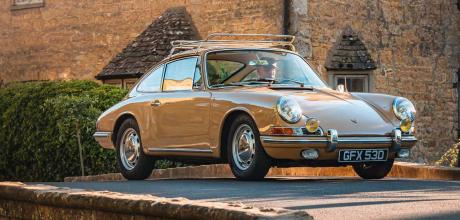1966 Porsche 912
A car that’s always been in the shadow of its 911 relation, the Porsche 912’s attributes and significance have for too long been overlooked and seriously underestimated.
Written by Kyle Fortune
Photography by Simon Jessop
UNDERRATED: THE CLASSIC 912
Does the early 911’s little brother deliver a drive to rival its six-cylinder sibling?
Test drive: Porsche 912 — Kyle Fortune gets to grips with the four-cylinder 912. Can it hold a candle to its six-cylinder counterparts?

“The 912 underlines my assertion that driving pleasure shouldn’t always be in related to power”
Sitting among the beige brickwork of a quaint, quiet country village, this 912 – the colour of its delicate arches and flowing lines serendipitously matching its surroundings – is at rest after a day exploring local roads. You can find out how the 912 stacks up as an alternative experience to a classic 911.

The best thing you could do to that is put a flat six in it,” was a friend’s comment when spotting a Porsche 912 parked up in Brescia, Italy. I remember it well, and it still troubles me to this day. The 912’s always been something of an enigmatic model, but to write it off because of its cylinder count does it an enormous disservice.
Introduced a year after the 911 reached showrooms, Porsche had never really intended to produce a four-cylinder derivative of its new car. Yet with the new six-cylinder 911 at a higher price point than the dated 356 and the detrimental impact that would have on sales, something needed to be done. Plans were hastily devised to add the 616/36 push-rod iteration of the 356’s flat four engine in the back of a 911 body shell. That engine, derived from the 356 SC, had a 1,582cc capacity and produced 90hp at 5,800rpm and 122Nm of torque at 3,500rpm.
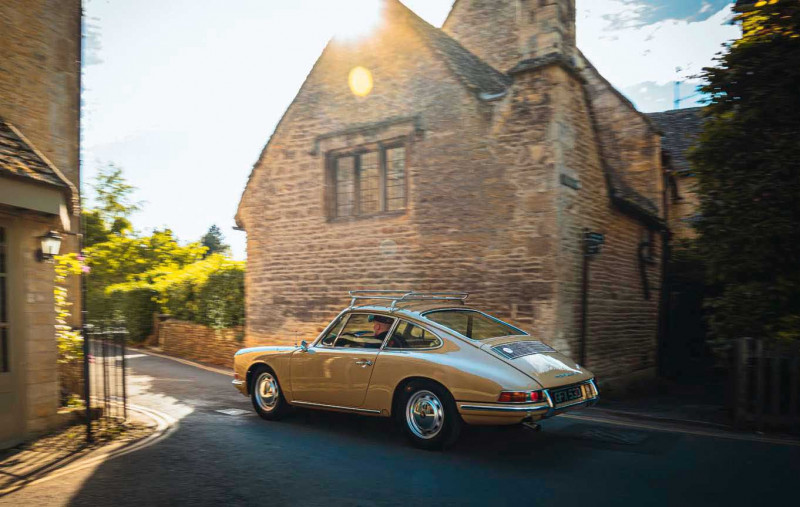
A relatively simple drop-in job, Porsche’s engineers achieved their task in a few months, with the new four-cylinder car gaining the 912 badge.
Obviously, Porsche did explore other engine options that, among others, included creating a four-cylinder version of the 911’s 2.0-litre, but the eventual engine choice was the simplest solution and also opportune for Porsche at the time. The company’s industrial engine division (Porsche Industrie Motor), which had produced a number of 356-derived 616 air-cooled engines for commercial applications such as marine, aviation, agricultural machinery, pumps and generators, was winding down, and Porsche had preexisting production agreements and contracts with its suppliers. The 912 would enable Porsche to fulfil those agreements, and provide a car for its customers at a lower price point.
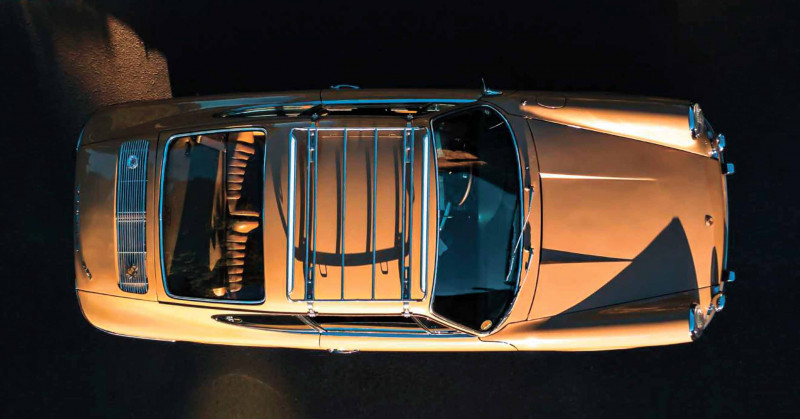
The new model was available from April 1965, and it did exactly the job Porsche wanted it to do: become a bestseller. In its first year of production, the 912 accounted for 6,401 sales, or almost double the 3,390 number of 911s that Porsche sold in the same period. That trend would continue through 1966: of Porsche’s 12,820 total sales, some 9,090 were 912s. In 1967 a total of 6,472 of Porsche’s 11,011 sales were 912s. Indeed, it would be 1968 before the 911 would overtake its four-cylinder relation – and only just – with the 911 accounting for 56 per cent of Porsche’s sales.
Successful, with its production run in excess of 32,000, but short-lived, the 912 would be replaced in July 1969 by Porsche’s new entry-level model: the 914. Porsche’s decision to remove it from the price lists was more a result of the potential costs to push three different engines through America’s ever-stricter emissions regulations, rather than a lack of demand for it (the new 914’s four-cylinder being a Volkswagen unit, as opposed to the 912’s 616/36 Porsche one). Indeed, some company insiders wanted the 912 to remain in preference to the joint venture VW-Porsche 914 model, which some considered as being detrimental to Porsche’s brand image. In 1976 the 912 would briefly return as a G-Series model for the US only. Fitted with a 2.0-litre flat four, it was a stop-gap, fuel-efficient, entry-level model that slotted between the end of Porsche’s 914 production and the introduction of the 924.

The 912’s conception and life cycle might have been quick, but it wasn’t particularly so on the road. Contemporary testing of the car saw it reach 60mph in around 11.5 seconds, with its maximum speed being around 115mph. By comparison the 2.0-litre 911 of the same period managed that in around eight seconds and boasted a top speed in excess of 130mph. The 912’s lack of performance didn’t harm sales, though: its lower price point, better fuel economy and fine build quality appealed to Porsche’s customers.
To achieve its more attractive pricing, Porsche stripped out some trim and equipment. Early cars featured only three dials ahead of the driver, while the 911’s wooden steering wheel was replaced by a plastic one, with a simple horn button instead of the 911’s butterfly push arrangement. Similarly, the wooden lower dash trim was removed in the 912, and outwardly 912s were supplied with painted wheels rather than the 911’s chromed or optional alloys. There were options for the 912, notably a five-speed manual instead of the standard four-speed.
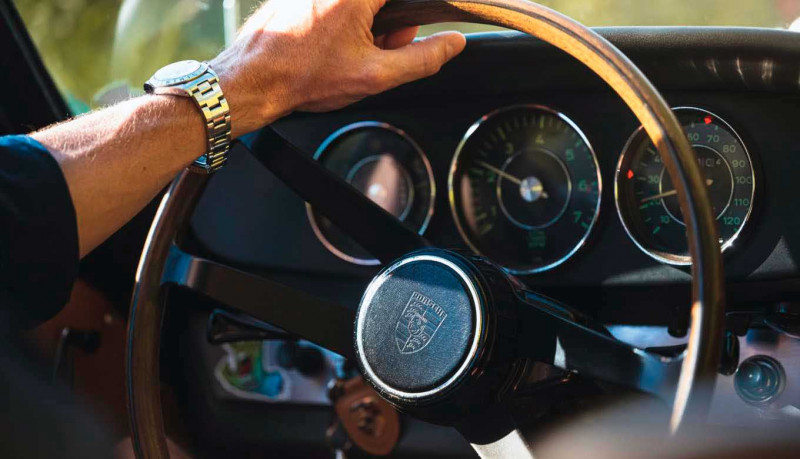
The five-speed manual utilised slightly closer ratios, which better suited the engine’s output. The loss of a pair of cylinders and the dry sump oil tank required with the 911’s flat six, as well as the 912’s slimmed-down standard trim, saw it weigh around 100kg less than its 911 relation. A sizeable portion of that reduction was around the rear axle, though. That, unsurprisingly, was beneficial to the 912’s handling, with its weight distribution of 44/56 per cent front/ rear better than the 41/59 per cent of the 911 that, as with the 912, was still in pre-‘69 A-Series short-wheelbase specification.
While it was outgunned by its more powerful 911 cousin, the 912 was noted for its less-tricky handling. That slight yet significant reduction in mass behind the rear axle made its dynamics a little more predictable, particularly on the limits of grip and traction. What speed it could muster wasn’t necessarily gained by grunt, then, but instead was aided by agility. The 912 gained praise as an enjoyable driver’s car, despite its relatively modest performance. The delicate, tidy handling, smaller-engined 912 isn’t alone in the car world as being overlooked for more powerful, bigger engine versions. When driven it certainly has its own appeal, while being slightly different in character to the 911.
I’ve yet to discover that, because arriving at our photo location to meet Toby Lamb with his 912 and photographer Simon Jessop (himself a 912 owner), I’m too busy poring over the details to think about wheel time. The 912 is registered as a 1966 model. However, Toby explains that because it’s a left-hand-drive example which was delivered to San Francisco in February 1966, it was actually built late in 1965. That’s underlined by the wheels which are dated 1965, making this 912 an early car. It lived in the US until around 1990, when it was shipped to the UK as a one-owner, matching numbers example, before Toby bought it in 2014.
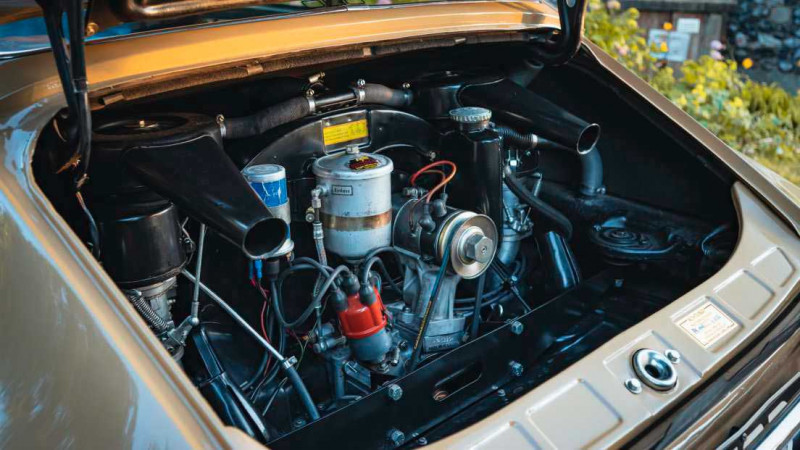
Toby works in fashion and admits that a big draw to this particular 912 wasn’t just its history and originality, but its colour. Called Sandbeige (6607) it looks incredible in the sunlight we’re enjoying at our photo location of Titsey Hill, Surrey. He’s also keen on the short wheelbase models and with a background of attending VW shows like Bug Jam, he admits to always being fascinated by the 912. Not that he hasn’t owned and enjoyed 911s, with a 964 before the 912, and a 993 for a time alongside it. The 993 has since been moved on, but he’s held on to the 912, which speaks volumes for his affection for it. “I love its short wheelbase, and the colour, and all the details – it’s just a cute little thing,” says Toby.
Combined with some period-correct accessories that set it off perfectly, Toby has added Euro-spec headlights as well as 118 Hella fog lights on new metal horn grilles above the bumper, and a set of 128 Hella fog lights under it. He’s also fitted new hubcaps to those date-stamped wheels, an AMCO bar on the rear joining the bumper’s chrome overriders and, of course, the roof rack, which he admits doesn’t get any real use, but looks cool. “I keep adding weight to it,” laughs Toby, but his choices really work.
He didn’t just stop with some nicely specified, bolt-on accessories, either. The car’s recently had an engine rebuild, and while it was out it seemed sensible to make some improvements. The capacity is now 1.8 litres and there’s an electronic ignition and fuel pump feeding it, with the pump drawing from a new fuel tank. Toby says it runs as it should now, and while he admits he was initially worried about making the changes, the first time he drove it the difference was so marked that he knew he’d done the right thing. Not just in relation to the performance, but also the ease of use and driveability: it feeling torquier, with keener revving. That it’s easier to start and friendlier in traffic is a bonus. He’s done a little over 1,000 miles in it since that engine rebuild, although looking in the engine bay you’d struggle to notice because it’s immaculate.
It might all be beautifully presented, but this 912 is no show car. Toby’s partial to setting his alarm early and taking it out before his kids wake up, although he’s also fitted some rear seatbelts in it for the odd family trip in “The Peanut”. It sits marginally lower than standard, although it rides on the correct Koni Classic shocks all round. There’s a set of 165/80 R15 Vredestein T-Trac tyres on those chrome hubcapped 15-inch wheels, while inside the steering wheel has been replaced by a wooden-rimmed OEM item.
There’s also a wooden gearknob. That knob’s graphic underlines the original owner paid $75 more for the five-speed transmission option. It features a dog-leg shift, with first left and down with reverse above it, before a conventional H-pattern for second, third, fourth and fifth gears.
It’s little surprise that the 912’s interior feels familiar, with only some hints to being different. It’s what’s not there that differentiates. Most obviously there are only three dials in front of the steering wheel – much like the 356 that the 912 effectively replaced – the 912 doing without the combined oil pressure and temp gauge and the clock that feature in its 911 cousin. Not all 912s were so equipped, with many gaining optional instruments. This is why you’ll see ‘five-dial, five-speed’ in 912 classifieds – not that we’ve been looking, oh no… There’s something appealing about the simplicity of the three-dial setup in Toby’s car, though, with paucity of the superfluous being evident elsewhere. Yet it’s far from an austere interior, feeling no poorer an environment in fit and finish than its 911 contemporary.
If the driving environment’s largely familiar then so too is the sound when turning the key to start it. Though not like you might imagine. The sound is Porsche from another era, thanks to that 356-derived engine. It’s not quite as physically percussive in the back of this car as it is in the older 356 one thanks to the 912’s stiffer, more modern (relatively speaking, here) body, but the familial link is strong. The misinformed might say it sounds like a Beetle, which isn’t wholly incorrect given the peoples car’s inextricable link to flat four, air-cooled engines, but under that engine lid is a genuine Porsche engine. What’s significant is that it doesn’t sound wrong. Different, yes… but there’s something about a boxer configuration engine’s character that’s so intrinsically Porsche that the cylinder count doesn’t really matter. And nor should it.
The flat four in The Peanut feels particularly keen. It’s very free revving, with the lightest brush of the accelerator seeing the revs flare. The clutch is light and the five-speeder is very much of its era, which means a bit of practice is initially required to work your way through the gears, but it soon feels natural enough. Anything with a dog-leg manual always feels a little special, too, and so it transpires here – pulling left and back for first and pulling away. There’s plenty of low-rev torque to shift the 912 without the need to work that engine. However, when we’re on the road it quickly becomes apparent that there’s some enjoyment to be had from running the engine up through its entire rev range, where it feels brisk as opposed to fast – at least by modern standards. That’s not a negative. Indeed, it’s a sizeable part of its appeal, because you can make a real difference by adapting your driving approach. To maintain speed it’s a case of working your way down the road, carrying momentum through bends, rather than simply being a case of relying on power to achieve the same result.
There’s real balance in the chassis to allow that, too. The 912 feels that little bit lighter, the steering a touch more alert and assured. All of which combines to aid with that immersive, hugely enjoyable driving experience. The 912 underlines my assertion that driving pleasure shouldn’t always be related to power – Toby figuring his engine’s pushing out around 110hp – but instead an amalgam of all the differing elements that combine to create the driving whole. With the 912, and this 912 in particular, it’s an absolute joy, feeling your way down the road, rev-matching downshifts for some pace through and when exiting bends, with the engine giving just enough performance to make decent progress, but at enjoyable, and more often than not, still legal speeds. As with any narrow, early Porsche there’s so much road to exploit, too. Even on the UK’s country roads, the 912 feels deft, playful and eager. The way it flows and the fun to be had while aiding that is a hugely entertaining experience. Yes, it would be faster with a flat six in the back but, right here and now, I’m not sure you could convince me it’d actually be any more fun. Don’t tell everyone, though, because that “six-is-best” mindset means 912s remain relatively affordable, and long may they remain so.
LEFT An optional five-speed gearbox better suited the 912’s engine output, and contributed to the car’s reputation as being an enjoyable drive.
BELOW The 912, with its flat four engine, could achieve 0-60mph in around 11.5 seconds, with a top speed of 115mph.
RIGHT Released in 1965, the Porsche 912 was a hit with customers, and sold well until it was replaced in 1969 by the 914 BELOW The 912 weighs 100kg less than the 911 from the same period, with a 44/56 per cent front/rear weight distribution resulting in decent handling.
BELOW RIGHT Three dials instead of the usual five feature on the dashboard, while other cost-saving measures occur throughout the 912’s cabin.


